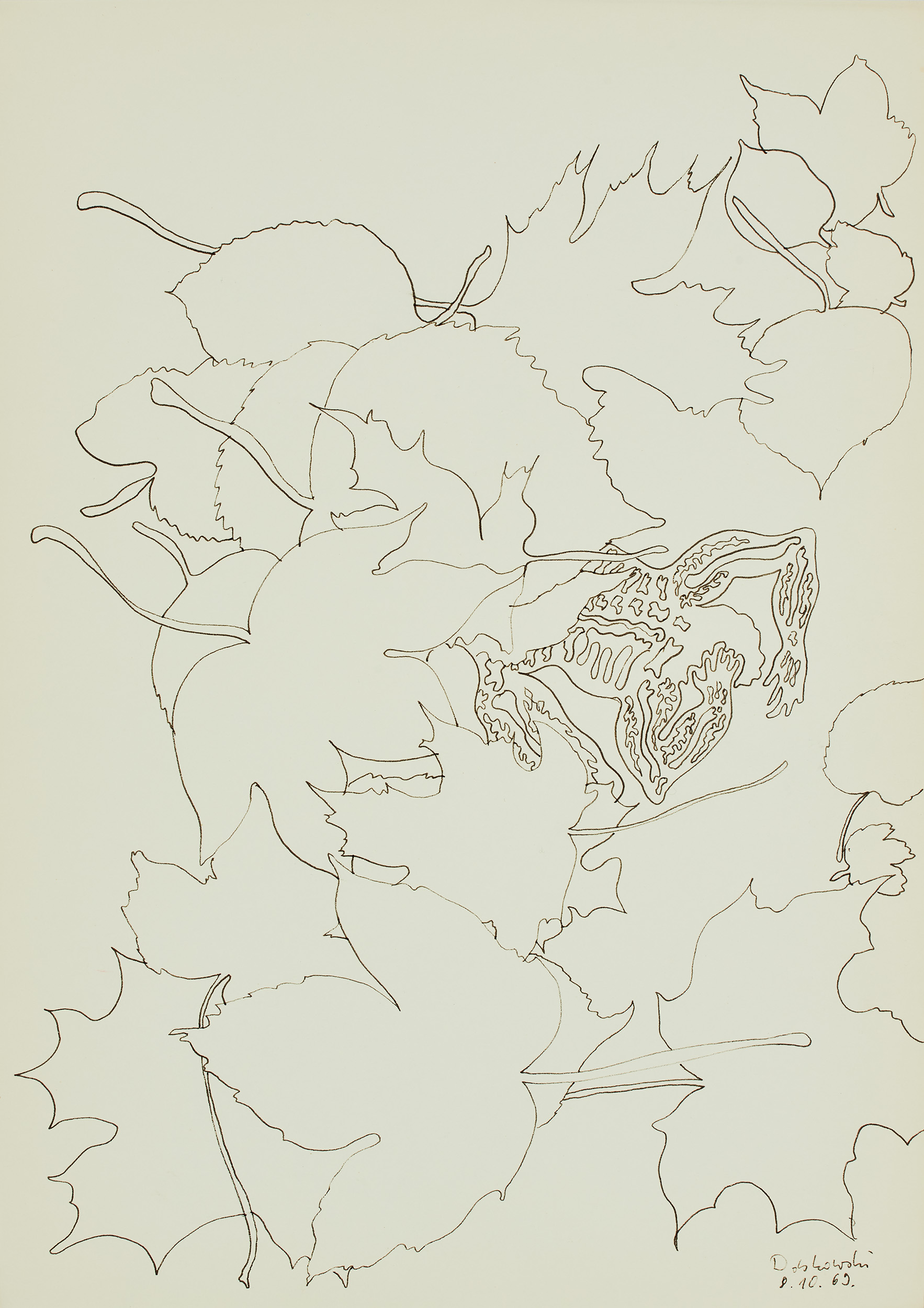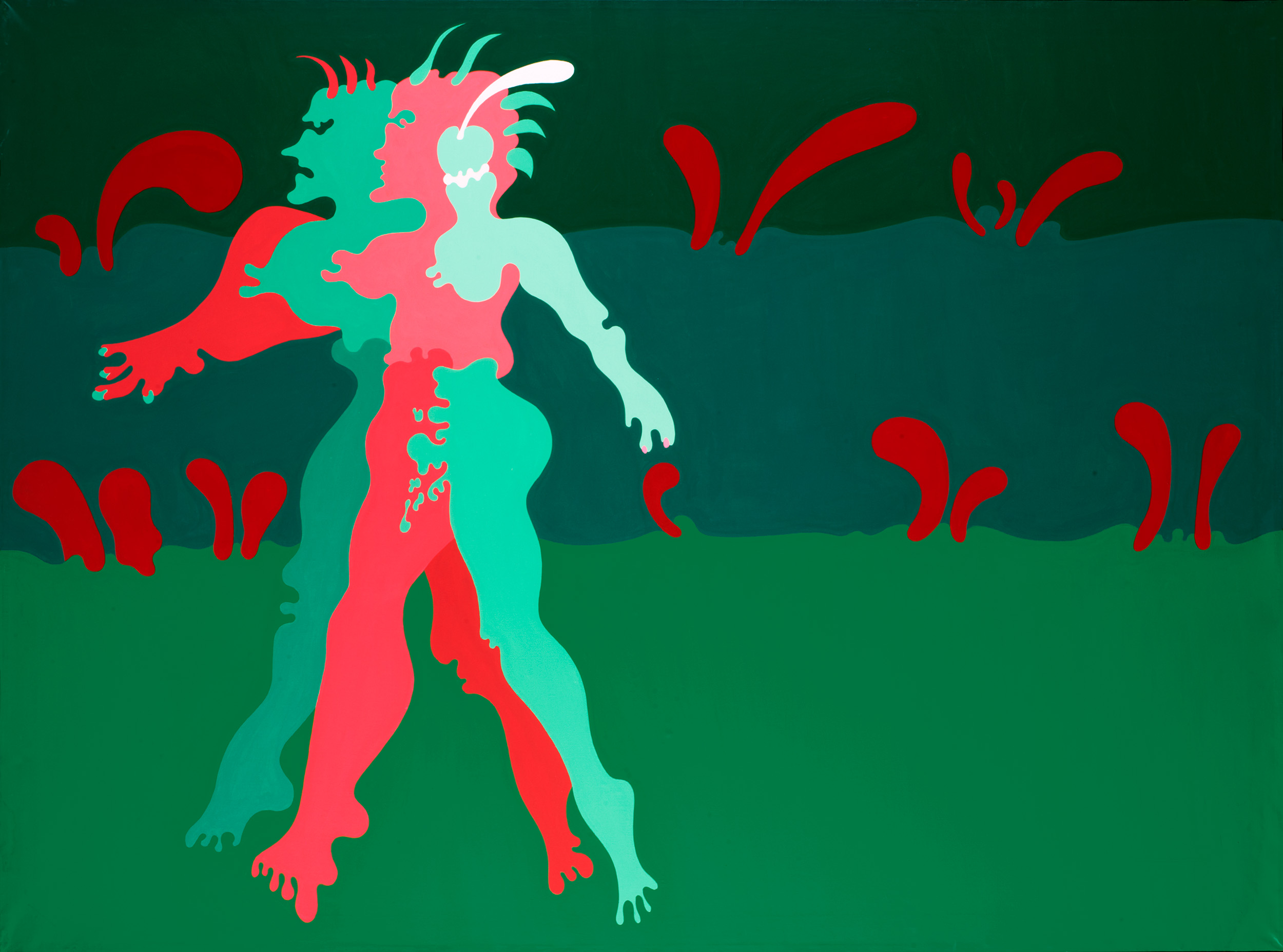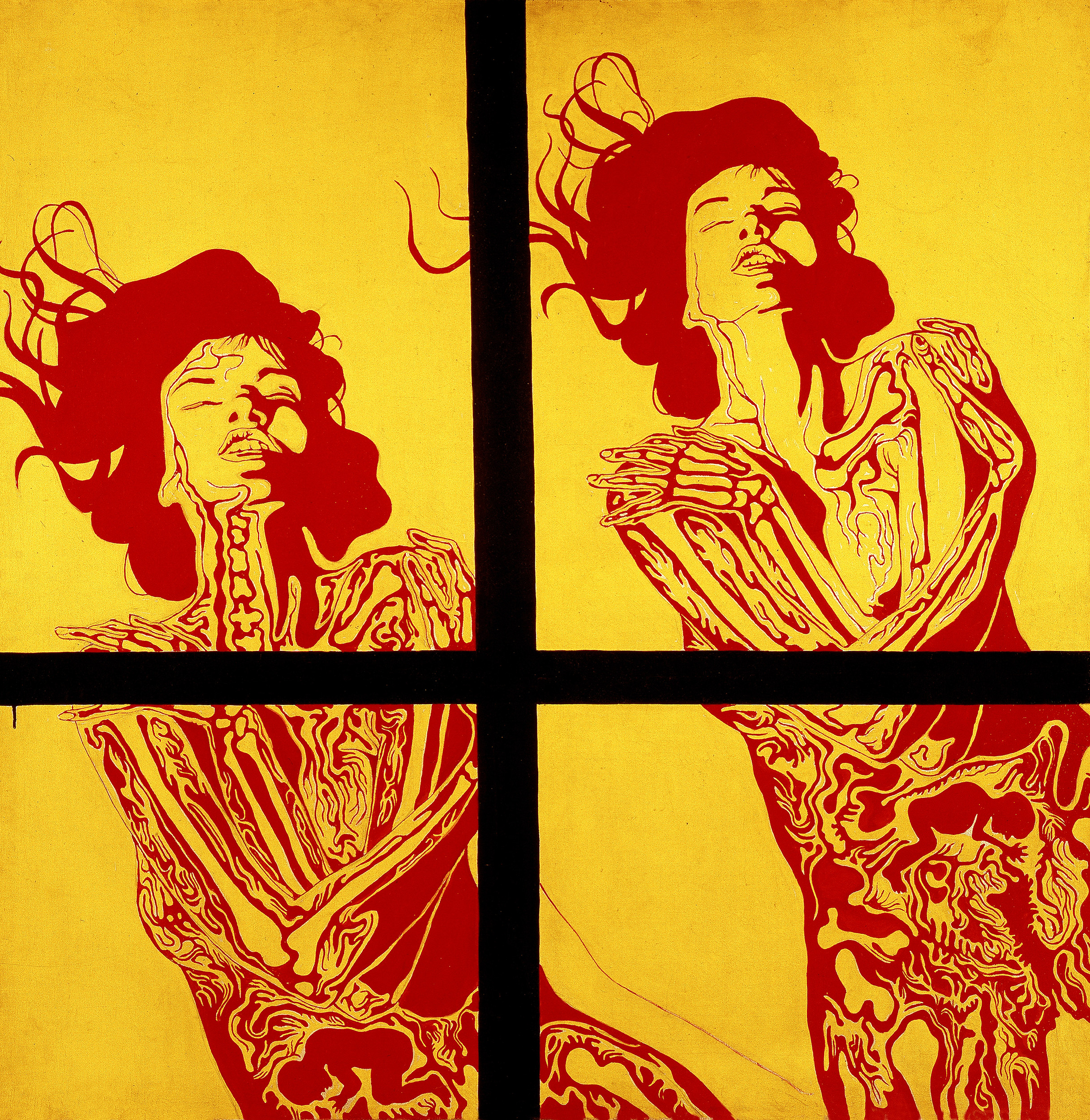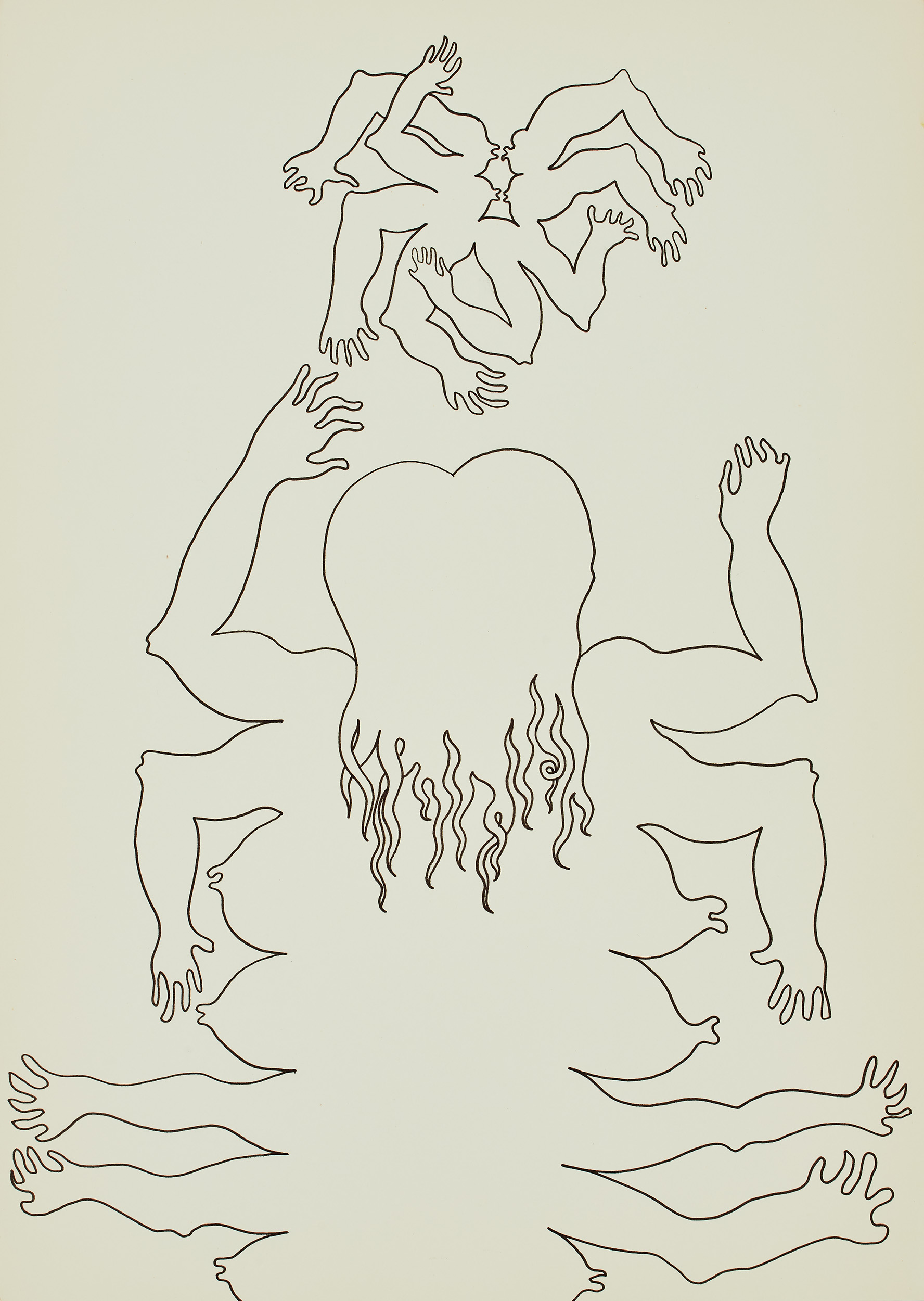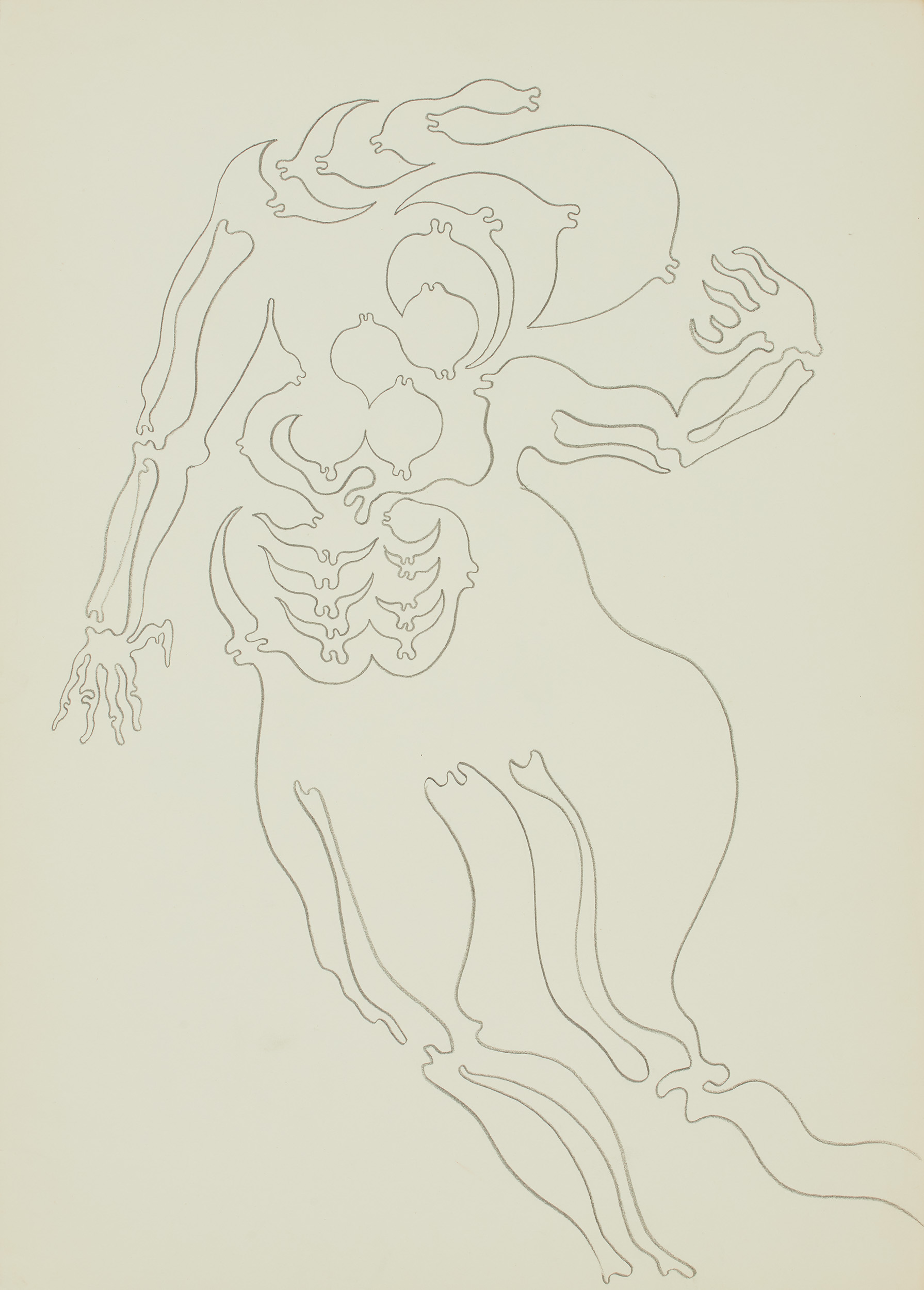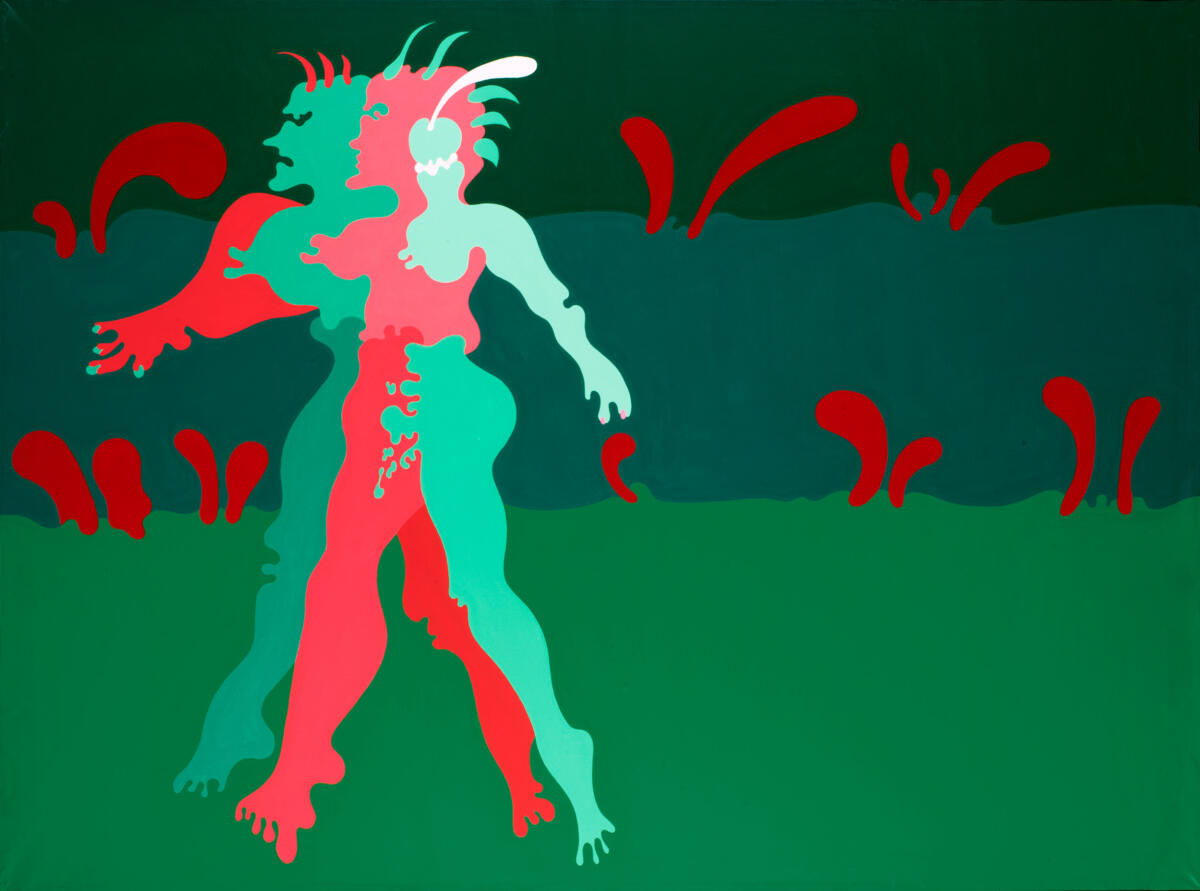
We need to think differently about ourselves and our systems of values, starting with adequate cartographies of s embedded and embodied positions.
Rosi Braidotti[1]
Figurative or not, the line is no longer a thing or an imitation of a thing. It is a certain disequilibrium kept up within the indifference of the white paper.
Maurice Merleau-Ponty[2]
Across more than six decades, Jan Dobkowski has produced a remarkably consistent body of work. This observation does not simply acknowledge that the artist has a unique and recognizable aesthetic in his approach to painting, drawing, sculpture, reliefs, and actions; rather, Dobkowski’s practice proposes a sensitive ecological view of the world that has largely remained undeviating throughout his many stages of production. His pictures propagate a pantheistic philosophy grounded in the acknowledgement of constant metamorphosis and interrelation, a concept as ancient and eternal as life itself, but one that gains added prescience as we better understand our interconnected and increasingly precarious world.
His work contests what Alfred North Whitehead called the “bifurcation of nature,”[3] refusing divides between matter and energy, body and mind, space and time, masculine and feminine, living and non-living, human and non-human, and even between organisms and their environments. Dobkowski’s images are reflections on how such borders can be overcome, rejecting dualisms by imagining modes of existence built on entangled and sensual relations and a logic of continuous metamorphosis. Using an “incomprehensible and infinite”[4] line as a machine to generate and undo forms, Dobkowski maps out permutations of embodiment that are intimate, outlandish, and lacking in fixed identities. Although this text will primarily examine the status and behavior of bodies in Dobkowski’s practice, this is not an exercise in anthropocentric thinking; rather, this essay will consider how Dobkowski’s polymorphic envisioning of bodies and their relations offers an ecological paradigm of liberation that embraces a world in flux. The constant transformation of nature is Dobkowski’s credo, which he channels as a threat to rigid structures, especially those that classify or entrap entities and their individual and collective expressions. Dobkowski produces narratives of change either by drafting shapes that call attention to bodily behavior, or by layering marks that build social realities and activate physical affects in the body of the viewer. Despite the appearance of a distinction between these formal gestures, this essay will try to understand how Dobkowski’s use of these interrelated technologies renders the body malleable and makes visible micro- and macro-interrelations through the unsettling of form.
Dobkowski’s polymorphic figuration harks back to ancient and ubiquitous symbolic practices that use images of other humans to activate the viewer. In numerous statements, the artist has asserted that his use of the human body has been in aid of erasing the divide between humans and what is referred to as “nature.” By defrocking humans from their vestments, literally and figuratively, he exposes naked apes “without attributes of culture or civilization.”[5] This reversion to a moment before society and its logics of power includes a reshaping of fundamental conditions dividing self and other, humans and non-humans, which is at once political, ecological, and metaphysical. From Dobkowski’s images, the “body” emerges as a mode of expression that can generate more connections in and to the world, a malleable interface unencumbered by the repressive and fixed orders in which we live. Key to this endeavor is the rejection of ossified gender and sexual boundaries, which helps us become aware and make sense of our own inherently queer, flexible, and multiple identities. By describing intimacies outside of normative rules and logics of desire, reproduction, or power, Dobkowski advocates a spiritual and sexual revolution that channels libidinal energy into collective change. Often described in the context of the 1960s counter-cultural movement, his work not only has many formal affinities to that of the hippies, but is also motivated by similar political, social, and spiritual sentiments, understanding that liberation demands a shift in consciousness and a reappraisal of social arrangements that have been falsely “naturalized.” Like psychedelic art, his works conflate human and non-human morphologies, borrow from Art Nouveau and Symbolism in style and substance, and feature melted, “tripped out” forms that recall the phenomenological, ontological, and epistemological transformations experienced during the use of psychedelics. This interest in polymorphic and entoptic phenomena is as much indebted to hallucinatory experience as it is to indigenous and prehistoric knowledges, which offers Dobkowski models of being and embodied understanding that are transindividual, functionally abstract, and deeply entangled with the environment. With his images of the body, Dobkowski proposes a radical body politic through which new worlds, assemblages, and affinities can emerge. Contorting form, his works constitute “an upheaval, a unique protest against the metaphysical immobility of the once-and-forever given,”[6] to use the words of filmmaker and theorist Sergei Eisenstein.
Each of the bodies in Dobkowski’s pantheon has an evanescent and multiplied identity; they are beings in transition that are captured momentarily in the midst of metamorphosis. This polymorphic capability to shift and change form is what Eisenstein described in the early animated cartoons of Walt Disney:
The rejection of the constraint of form, fixed once and for all, freedom from ossification, an ability to take on any form dynamically. An ability which I would call “plasmaticity,” for here a being, represented in a drawing, a being of a given form, a being that has achieved a particular appearance, behaves itself like primordial protoplasm, not yet having a stable form, but capable of taking on any and all forms of animal life on the ladder of evolution.[7]
The director termed this principle “plasmaticity,” based, of course, on the omnipotence of plasma, which contains in “liquid” form all possibilities of future species and forms. Dobkowski’s infinitely elastic line descends from this primordial soup, this “protoplasm” from which all life develops. He harnesses a fluid substance from which flexible forms can emerge and change in a continuous amoeba-like contour. His work imagines an atavistic return to a moment before phenomena and identities have been formatted, measured, objectified, governed, and socialized,[8] inspiring a sort of ontogenetic memory that recalls the unconscious trace of our own evolutionary transformations.
Like an animated cartoon, Dobkowski’s world is one that is liberated from the laws of logic, behavior, physics, or biology. Hierarchies are annulled, and any semblance of established stability is erased. For Eisenstein, the cartoon’s plasmaticity gives the viewer an ironic illusion of infinite metamorphosis within their standardized and controlled society, serving as an exaggeration of the magical ideology of wish-fulfilment in capitalism and modernity: “A lost changeability, fluidity, suddenness of formation – that’s the ‘subtext’ brought to the viewer who lacks all these.”[9] Dobkowski’s paintings, drawings, and sculptures propose a radical freedom from strict social orders, yet this is not simply a romanticization of a more innocent time. Though he would likely assert that his work aspires to an almost prehistoric universality, the narratives he generates are, in fact, emblematic of late modern existence, which strives for “omnipotence,” the ability to become “whatever you wish.”[10]
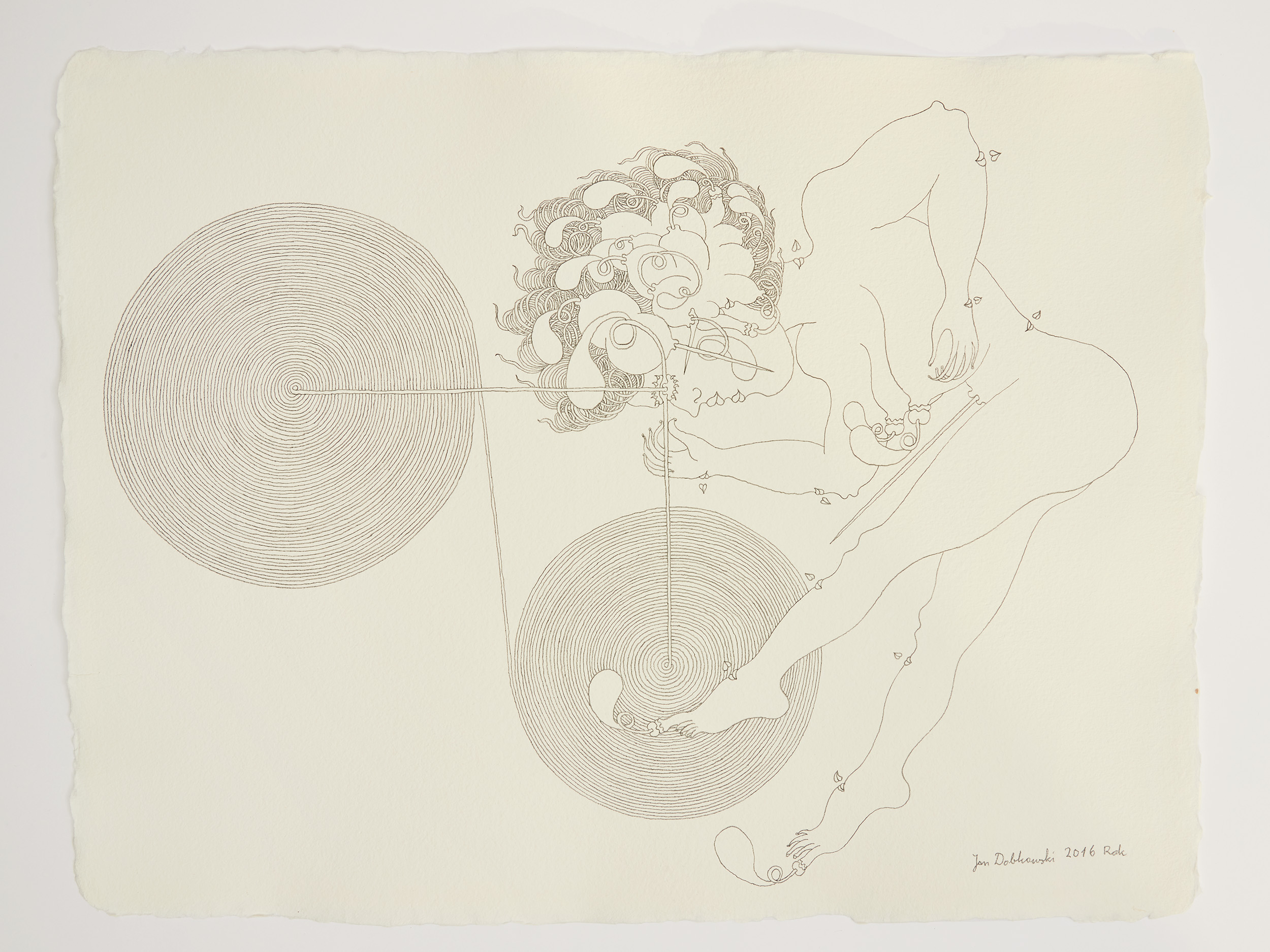
Jan Dobkowski, from the series ‘Take a Swing on the Thread of Life’, 2001–2011, pencil, handmade paper, 35×44 cm, private collection
Dobkowski’s vision of unstable forms has only become more relevant in the increasingly volatile state of our world. The sociologist Zygmunt Bauman proposed that modernity has always been infatuated with almost compulsive and continuous transformation. Though modernity at first involved attempts to make society “solid” through rationalization – the control of nature, hierarchical arrangements, rules, and categories – it can also be characterized as a struggle for emancipation from stable forms, to “melt solids”[11] à la Marx and Engels, and overthrow tradition and traditional forms. But at the dawn of the 21st century, this process began to apply to society, dissolving traditional social bonds, identities, hierarchies, and institutions. This transition from solid forms to more fluid and unpredictable social, economic, and cultural relations is what Bauman refers to as “liquid modernity,” where “flexibility has come to replace solidity as the ideal condition to be pursued of things and affairs.”[12] Instability now permeates all levels of our lives, “where the expectation of change is the only permanence, and uncertainty the only certainty.” Where the changes of modernity were once directed toward a state of equilibrium, Bauman points out that infinite change has become the norm: “As time flows on, ‘modernity’ constantly changes its forms in the manner of the legendary Proteus,”[13] the Greek sea-god of elusive change who was mutable and capable of assuming many forms. Thus, Dobkowski’s figures are not simply fantastical creations in contrast to a more rigid or conservative society, but rather are reflective of this ubiquitous expectation of constant transmutation.
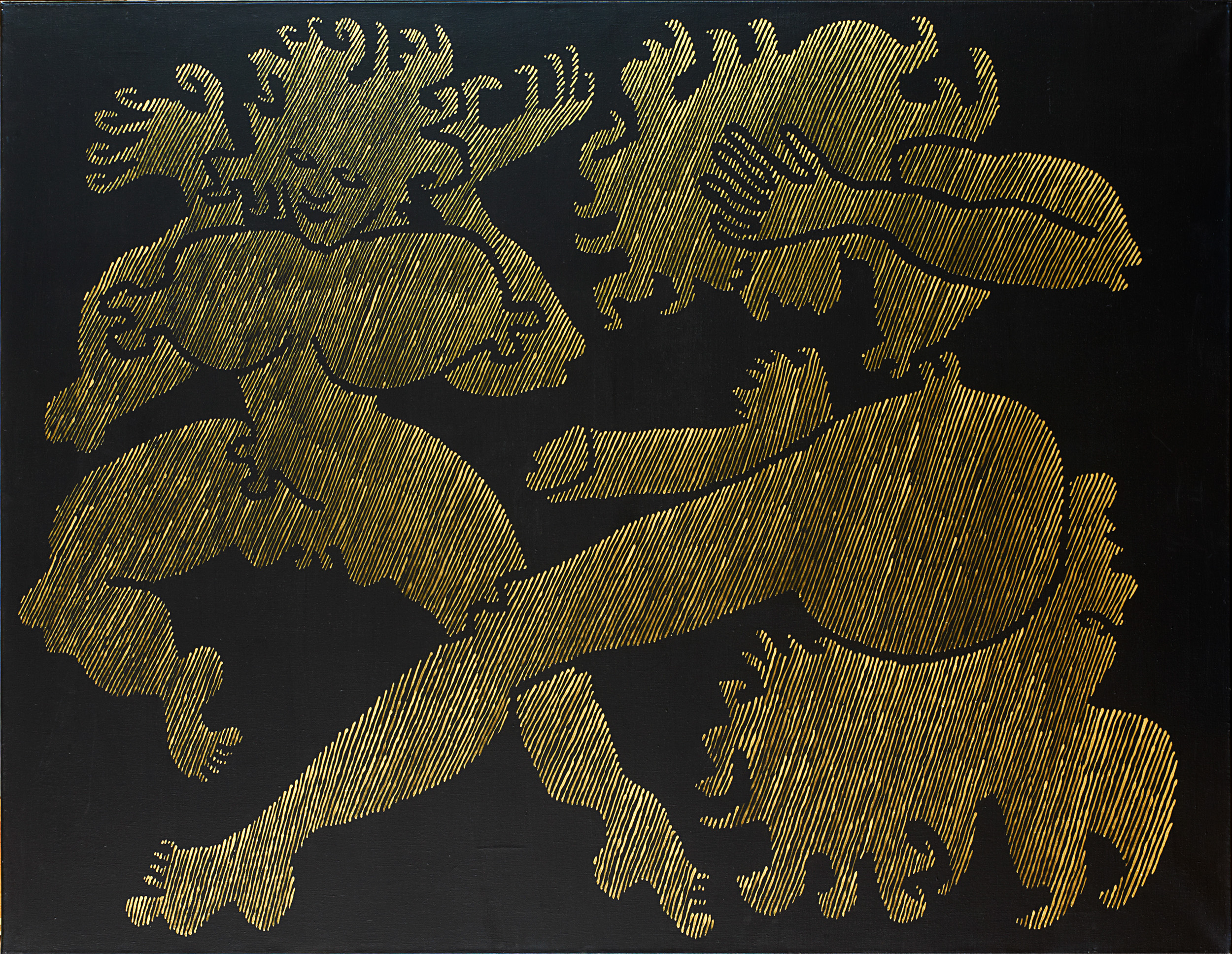
Jan Dobkowski, ‘Carnival in Rio XXIX’, 2005, acrylic, canvas, 114 ×146 cm, private collection, photo: Maria Dobkowska
By conjuring the figure of the mythological shapeshifter, Dobkowski’s depictions give attention to an ancient protean moment before form became solidified. Each image is a primordial map, a “blueprint of a genesis of things,”[14] as Maurice Merleau-Ponty would say, yet they also anticipate each form’s precarious temporariness and inherent mutability. A substantial part of Dobkowski’s extensive oeuvre features figures that are arrested somewhere between their emergence into form and their disappearance into the formless. Creation and destruction are shown not as opposites, but equal parts in a continuum of plasmatic transformation. Writing on the peculiar figuration found in animation, Keith Broadfoot and Rex Butler speak of a “figuration in which the figure is no longer opposed to its dissolution but only given […] in or as its very dissolution.”[15] In Dobkowski’s work, the sense of a figure is established with certain bodily markers, but this “essential” structure is immediately undermined and never returned to equilibrium. A form is delineated and then subjected to variations, movements, and flows. The plasmatic transformations the figures undergo are never directed toward an ideal realization, but rather are depicted incomplete. Like Bauman’s description of our age, the figures are “in a permanent disposition of becoming.”
In Janusz Zagrodzki’s essay “On the Thread of Life,” he observes that the line in Dobkowski’s work “becomes not only a means of expression, but also a principle of communication.”[16] In this respect, the representational and figural quality of his practice is secondary to the internal vitalism of his strokes. Despite their formal differences, Merleau-Ponty’s comments on artist Paul Klee’s line are informative:
The beginning of the line’s path establishes or installs a certain level or mode of the linear, a certain manner for the line to be and to make itself a line, “to go line.” Relative to it, every subsequent inflection will have a diacritical value, will be another aspect of the line’s relationship to itself, will form an adventure, a history, a meaning of the line…[17]
Dobkowski’s contours and curlicues catalyze narratives within the line itself, making visible a story of vulnerability, evolution, involution, and overturning. Though all of his works are inherently static and stable as images, the smooth flow of his figurative lines conveys slow, evolving movement. Every stroke and undulation signals a path and its deviation; every contour constitutes its own displacement.
Dobkowski’s curved lines can be compared to another extensive part of his oeuvre that features paintings and drawings made up of the dense repetition of individual marks. Resembling topographical maps or flickering waves, this body of work is often described as a departure from his more human-oriented works. Yet in many of the series using this technique, the body is still present as a micro- and macro-organism that is temporary and contingent. In the graphite series Genesis (1986–1987), clusters of protoplasmic forms manifest from the spaces between dense consolidations of lines. Alluding to cellular interactions and flows of energy, objects constitute themselves through their transversal, vibratory position within a unified field, where the inside and outside of the body are in reciprocal flux. The dancing and aroused figures in the series Carnival in Rio [Karnawał w Rio] (1997) and Nocturnes [Nokturny] (1998) are constituted by this same rapid stroke, but here they alternate between building their bodies and generating their environment, exposing the permeability of organisms. Dobkowski’s hypnotic fields of lines allude to a quantum understanding of the interrelation of particles and waves, an acknowledgement that, at the core, all substances are made of the same unified stuff vibrating at different frequencies. These works are also clearly inspired by the oscillating lines of Aboriginal Australian artists who use this logic of repetition and reverberation to depict their “dreamings,” where life-forces are inextricably intertwined with their environments. Dobkowski’s series Australian Dream [Australijski sen] (2000–2010) makes this reference clear by generating optical effects made up of fluctuating group dynamics within a unified diagonal downpour of colored marks. On a macro scale, one can identify Dobkowski’s idiosyncratic polymorphic bodies, and at another dimension, squiggles and wavy vibrations coalesce into amoebic shapes and almost prehistoric depictions of archetypical figures. All of these activities are united through methodical, compressed linear strokes. Operating as a code above and below conscious reality, these vectors direct force and describe a theory of multidimensionality manifested by the generative power of movement. The line becomes a universal substance that connects entities across magnitudes and species. Although it dispenses with the body entirely, the series Beyond Infinity [Poza Nieskończoność] (2001) similarly drafts ephemeral and indeterminate volumes out of crowded overlapping lines. Each colored mark is a singular body, a unique cell imbued with motivation and force, which join together to produce an animated assemblage, suggesting matter as motion. Through his building and dissolution of form, Dobkowski demonstrates that the idea of a body – or any object really – as an autonomous, stable, and separate individual, is simply an abstraction from a more complex and interrelated universe.
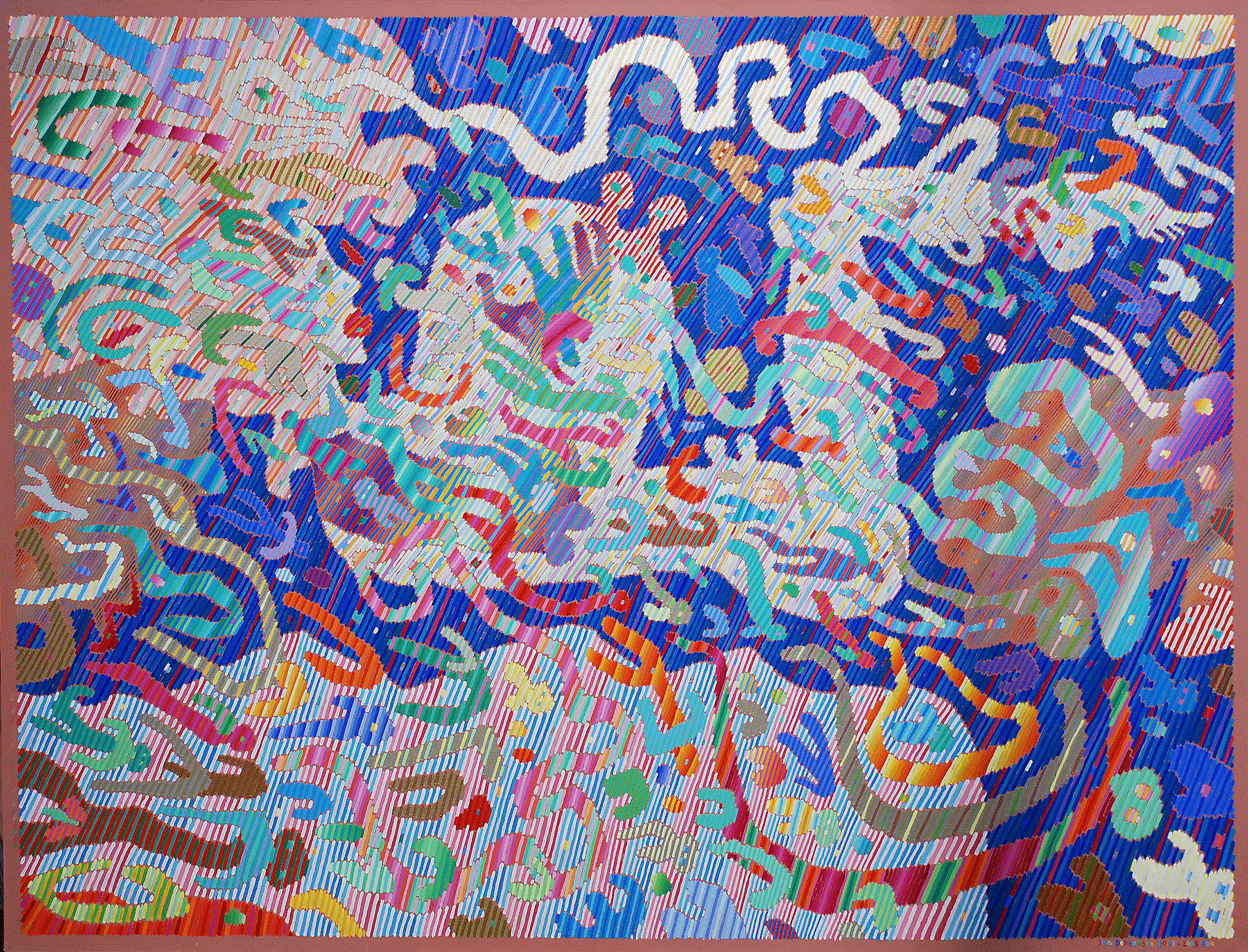
Jan Dobkowski, ‘Australian Dream XX’, 2008, acrylic, canvas, 147 × 197 cm, private collection, photo: Robert Wancerz
A purist could suggest that his forms are often just a stylized and abstract force which happens to arrive at shapes that are universal in nature, rather than deliberately describing figures as such. Under this logic, the lines give boundaries to a plasmatic substance that actively resists representation until, inevitably, human habit arrests it with language and identification. In many of his paintings and plexiglass works, the contours circumscribe puddles of pure color, generating embryonic shapes. In their fluid behavior, these forms recall lava lamps, the psychedelic light fixtures that offered a sort of plasmatic cinema to the quintessential hippie home. Like watching clouds, the forms offer the possibility of pareidolia: the perception and identification of patterns, objects, and bodies within chaos and formlessness. This is an innate human tendency, vital to our cognition and often our survival. Recognizing signifiers in random forms is both practical and symbolic – it regards the mess that is in front of us as well as predicting or speculating on actions in the future. One can think of the common Andrzejki divination ritual of recognizing forms in molten wax poured into cold water. The formless becomes an augury for the future, but this prognostication can only be used if one attributes meaning to the shapes. With only paint, plexiglass, pencil, or ink, the formations give a sense of anatomy, yet remain in an internal and abstract universe, removed from the day-to-day. This dialectic is one that Merleau-Ponty attributed to the paintings and cut-outs of Henri Matisse, arguing that the artist is adept at fitting “into a single line both the prosaic definition of the entity and the hidden operation which composes in it such softness or inertia and such force as are required to constitute it as nude, as face, as flower.”[18] Dobkowski introduces just enough recognizable form for the liquid compositions to be analogized to human silhouettes, playing with the tension between mark-making and the illusion it creates. The result is a discourse on figuration itself, where visible, recognizable, clear, and distinct shapes – marking the body’s contours – are introduced and then contorted under plasmatic logic.
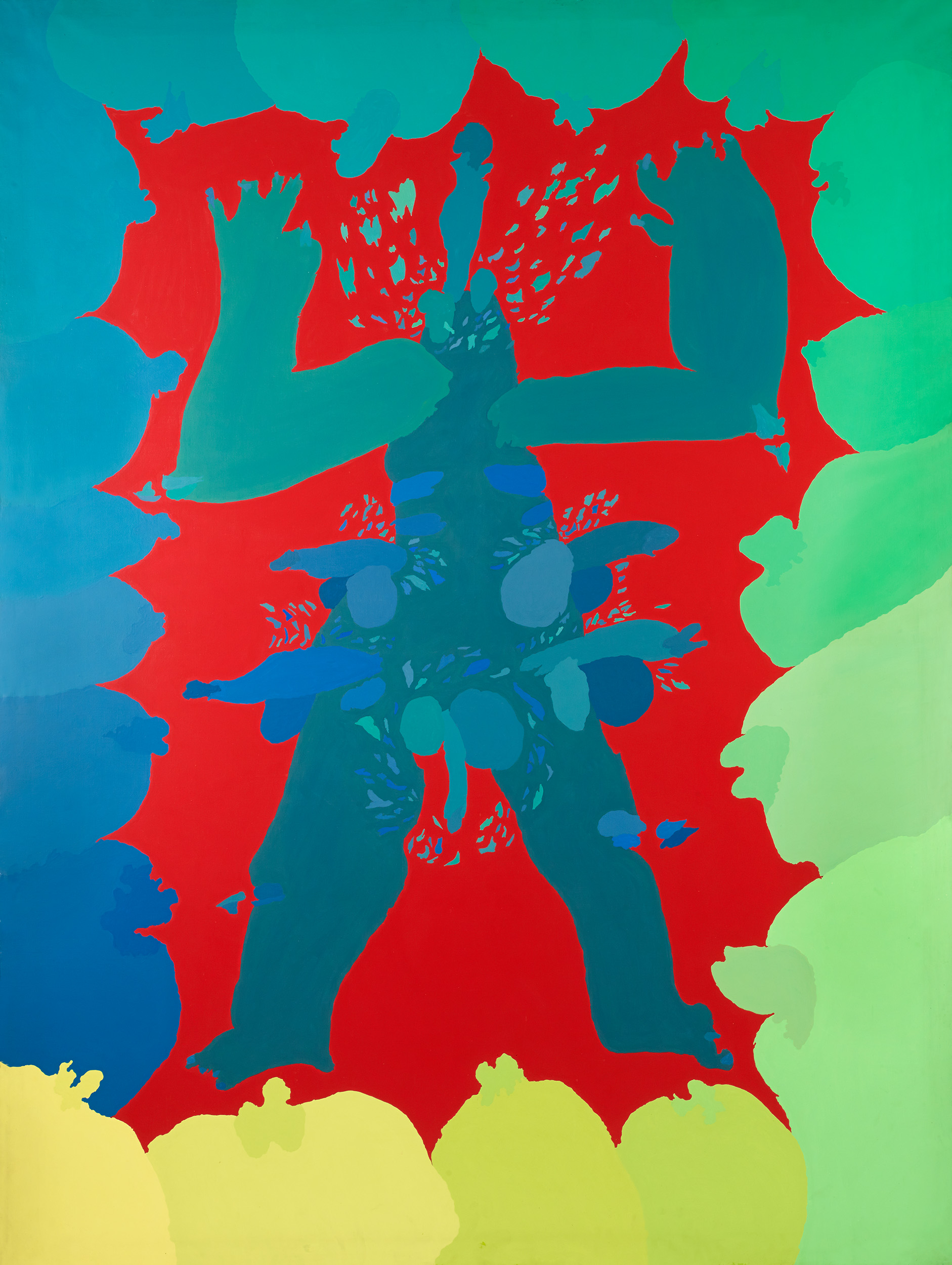
Jan Dobkowski, ‘Cornered’, 1975, acrylic, canvas, 197×147 cm, private collection, photo: Jerzy Malinowski
The silhouettes in Dobkowski’s celebrated “red-green” paintings imagine the body as a homogenous red mass in a field of green. Only through the learned conventions of figure-ground relations and Dobkowski’s adept deployment of complementary colors and color-theory principles do we discern a figure at all. Here, the inner and outer worlds are in constant negotiation, where zones of color engage in an intimate interchange. Volumes, differences, depths, and distances are reduced to flat schemata. Incorporated into the homogenous plane of pictorial space, there is no background or foreground in Dobkowski’s compositions, no topological difference between objects, figures, and environment. Things are plunged into flatness or radiate as wave-like reverberations around each other. His images take on a “flat ontology,” where hierarchies are erased, relations are levelled out, and any reference to the real is abolished.[19] At times, the background asserts itself and claims the role of figuration by interceding with the dominant body, grabbing at it with hands or contours akin to organs or genitals. When part of a figure intervenes with itself, the body often makes way, adjusting its form to follow the contour of a limb. In some of the compositions, there is even the accommodation of a full body within the body, which at various points has been identified as an embryo, yet one should not reduce the images to an idealization of human biology. A figure develops from the indeterminate mass and comes across another figure made up of the same substance. Due to protuberances that are reminiscent of genitals, the interchange can be seen as sexual, yet the behavior is much closer to that of unicellular organisms which alter their shapes by temporarily extending and retracting pseudopod-like appendages and aggregating their forms into a collective body. They adjust, reform, and enfold their bodies with regard to each other, generating points of contact or making space for the other within themselves. When these forms are translated into semi-transparent colored plexiglass, one sees more clearly the puzzle-like quality of the collective body, where pieces interlock to build new forms from disparate parts, generating a colonial organism greater than the sum of its parts, rearranging the body under alternative logic. The site of their joining is comparable to the ways that enzymes bind to their substrates in order to catalyze chemical reactions. Like a lock and key, specific kindred forms complement and match each other, preparing a space for their co-evolution. In polychromatic paintings such as Butterfly [Motyl], Cornered [Osaczony], and Euphoria [Euforia] (all 1973), this logic is applied to the social world, where discernible figures intermingle by interlocking their forms and fusing together into a collective assemblage. The crowd becomes not simply a congregation of separate individuals, but instead a conglomeration of body parts and affects. In A Walk of Spring [Spacer Wisony] (1974), a couple partaking in a spring stroll become a single, multifarious cluster of intermeshed morphologies, suggesting a diffused and multiple embodiment whereby the distinction between self and other is nullified through a plasmatic embrace.
In a number of Dobkowski’s works, markers of anatomy like bones or organs are also made visible, but they are flaccid, inconsistent, abstracted, and incomplete. In Astray [Błądzenie] (1968) a male figure stands behind a pair of opaque females without arms. The uneasy character’s skin is transparent, divulging his insides like an X-ray. We see bone-like structures that refer to femurs, spines, ribs, and phalanges, yet these parts are not held together by joints or muscle and are instead surrounded by wavy shapes akin to nerve cells or the intestinal track. Bliss [Rozkosz] (1967) appears to be a more faithful attempt at rendering anatomical structure, but this is also only an illusion. In quartered panels, the bodies of a pair of ecstatic women are filled in with bones, veins, and even unborn children. By tracing the forms from a photograph in classic Pop Art fashion (a rarity for the artist), there is the implication of accurate representation – a momentary inclination toward the medical – but this is indeed radiography gone amok, where the musculoskeletal and other bodily systems are only implied. Dobkowski’s depiction of the internal workings of the body is much closer to the tradition of Aboriginal Australian X-ray style art, where bones and organs are depicted within animal and human silhouettes. Like his venerable counterparts down under, Dobkowski makes visible only specific parts of the body, and conforms these structures to an abstracted and polymorphous contour. In Pure Nature [Sama natura] (1968), a wavy blue figure is stretched across the canvas and filled in with pieces of bone, innards, and a form akin to hair. The solidity of the skeleton is subjected to a softening; the rigid bones that hold us together become gelatinous shapes; the anatomist logic of connecting soft outer form to a stable framework within is undermined and debased. Throughout Dobkowski’s oeuvre, inner structures like the ribs become active and integrated agents in the external makeup of the body, which are then subjected to the flows of continuous change and metamorphosis.
Each protagonist in Dobkowski’s narrative is morphologically dubious, questioning the notion of fixed bodily form by focusing on what a body can “become” rather than what a body “is.” As liberatory as this possibility for transformation may seem, the theorist Vivian Sobchack has pointed out that the ubiquity of morphing, especially in digital media, is a reflection of an increasing cultural obsession with the idea of bodily change, reversibility, and metamorphoses within capitalism itself (echoing Eisenstein and Bauman’s claims).[20] Morphing is an expression of a larger shift in the physical status of the human body, and the blurring of its boundaries makes visible how new technologies (from plastic surgery to image manipulation) transform and produce our subjectivities. Forces are rendered visible through bodily manipulation. The human body has become malleable both physically and ideologically, and its transformation is thus an expression of the various ways in which power plays out across it. For Dobkowski, this offers the possibility of the emergence of new behaviors and embodied interactions, while also exposing the fragility, temporariness, and vulnerability of the body itself as it is subjected to forces which continuously redefine it.
Marking the moment when the human body becomes elastic, Dobkowski’s technique re-articulates the body, how we relate to it, and what we believe a body can do. If we can regard Dobkowksi’s images as humans at all, they are strikingly monstrous, queer, intersexed, transgendered, and transhuman. With fundamentally unstable identities, these bodies comfortably reside in a transitional and intermediate state, and freely thwart normative expressions of gender and interaction. The integrity of the body is in question, both in terms of it as a stable and singular organism, but also what parts of it give our masses of bone, blood, and flesh an identity. It would seem that in Dobkowski’s cosmology, the genitals and glands are the core of the body, from which appendages, faces, and other body parts manifest. At times, this can feel reductive, giving images a partialism or even some sort of perverse fantasy of a person as simply “tits and ass.” Yet this redistribution of the body and its organs is above all a parody and gives attention to those regions of the body that are often hidden or minimized in the history of representation. The crude obscenity or vulgarity of his images is not the result of divulging such “private parts” in public, but of reconfiguring their relations and subjecting them to absurd exaggeration. The body is reassembled under a new rubric akin to the somatosensory map that arranges the body according to how the brain processes tactile sensations. Instead of the face or the hands as the most abundant sites of sensory information, Dobkowski remaps bodily hierarchy by relocating stimulation to the eyes, nipples, toes, and genitals, redefining what those structures can do.
The uncanny, or even humorous, apprehension of his works is due to the fear of “unnatural,” transformable bodies, making visible the superficiality and imposed boundaries of gender and its expression. Speaking on how monsters inhabit similar “geographies of ambiguity,” Dana Oswald reminds us that:
We might look to the body—to sex—as a place of security, a means of stabilizing flexible and performative gender, but monsters reveal that the slippery nature of gender derives from the body, which itself is contingent, dependent, derivative—always in some kind of transition, even if we do not seek to change sex or gender.[21]
Dobkowski’s images uncouple the living body from all essences of gender, sexuality, or any other determination grounded in the ontology of the body as a stable, predetermined entity. Moreover, when markers of gendered identity or biological sex are given in the forms, they are exaggerated, conflated, and multiplied. Do we see men or women in these images? Absolutely not! Even when a figure bears a form that implies the biological specificity of the sexually differentiated human body, the performance is disrupted, denaturalized, and rearticulated. Breasts have their own breasts; enlarged penises erupt from feet or coil into spirals; vulvas emerge from anywhere, and twist, turn, and multiply. It is only due to the presence of other gendered markers or conventions that rotund shapes are recognized as breasts at all. At times, Dobkowski’s multiplication of mammary glands recalls statues of the Artemis of Ephesus, an Anatolian goddess from the ancient Mediterranean. The traditional interpretation of the pile of oval objects covering the torso of this antediluvian figure is that it represents multiple breasts, symbolizing fertility, but this is in dispute. Some have identified the ovoid shapes as eggs, grapes, or figs, and in 1974 the scholar Gérard Seiterle went so far as proposing that the figure is wearing a garland of bull testicles sacrificed in her honor.[22] Dobkowski’s figures are equally ambiguous, inverting and combining gendered signifiers and playing with the similarity of biological homologues that suggest a shared developmental path. When a character displays both a penis and a pair of breasts, or a beard and a vulva, it is not that they aspire to transitioning from one binary gender identity to another, or express some sort of unification of opposites, like a yin-yang symbol. This folly of attributing identity and role to gendered forms is present in descriptions such as Zagrodzki’s observation that in Dobkowski’s works, “the female element governs, leads, and initiates, while the male one receives and submits.”[23] Such a statement is crucially misguided, as it affirms traditional gender roles by identifying their binary reversal. By cancelling gender/sexual differences and the reproductive functions of genitalia, Dobkowski’s work calls cisnormativity into question, and disputes what genitals are expected to do and how they operate as indicators of actions, categories, or power. There is no masculine or feminine in these works, and no dysphoria or anxiety about not fitting between these limited options. Instead, the androgynous actants in his illustrations exist in a space before and after biological sex, and outside any assumed traits or norms governing their behavior.
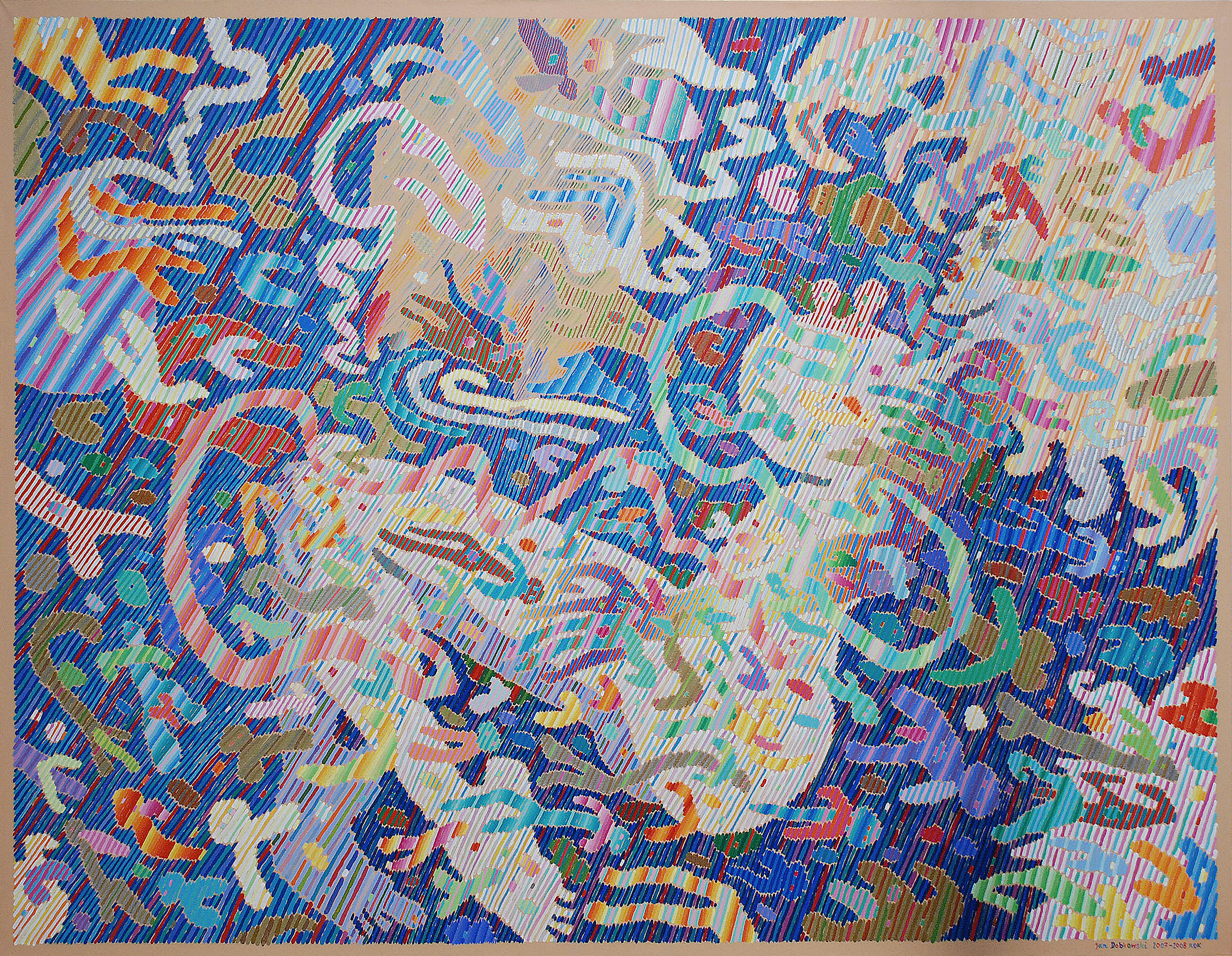
Jan Dobkowski, ‘Australian Dream XVII’, 2008, acrylic, canvas, 147×197 cm, private collection, photo: Robert Wancerz
In almost every text that concerns Dobkowski’s figurative works, the images are described as “erotic,” with very little qualification. Is it because of prudishness or the maintenance of Dobkowski as a “serious” artist that no one says directly what is in the pictures? Do these images arouse the viewer? Does the mere inclusion of genitals and unclothed bodily interactions elicit an analogy to pornography? Certainly, there is a logic of excessive sexuality in the images, yet the figures’ idiosyncratic dissoluteness, this mass indulgence in the carnal, is unencumbered by the expectation of copulation as a heterosexual or reproductive process. Indeed, with the exception of parts giving space to other parts and moments of self- and mutual fellation, there is almost no penetration in Dobkowski’s works (except once, on a figure’s kneecap). Instead, the bodies find other forms of shared stimulation and desirous expression. In his Three Essays on the Theory of Sexuality, Sigmund Freud suggested that the experience of sexual pleasure anywhere on the body is a rudimentary stage in childhood sexuality; before pleasure is narrowed down to the genital zones and we become aware of morality and shame, we have a “polymorphously perverse disposition.”[24] The 383 drawings in Dobkowski’s series Take a Swing on The Thread of Life (2001–2011) provide a comprehensive demonstration of how such “erotic” relations can function with undifferentiated libidos and unlimited bodily possibilities. Using only contour and obsessive curvilinear linework, the figures function as squirmy bundles of erotogenic zones in an intimate dance. Almost identical to twirling hair and blubbery breasts, their fluidly gendered bodies inspire a dissonance between otherness and sameness as they engage in amorous and inane exercises with each other. They are contaminated with forms that recall leaves, lips, vulvas, nipples, or bisected heart symbols, which sporadically appear at points along the contours of the figures. These shapes are almost always complemented by a floating counterpart outside the body, which together describe an immanent yet disembodied kiss. Such structures are apparent at precise junctions of the body, such as the nape of the neck, below the elbows and knees, and at the hip, as if they are designating erogenous zones, sites of hyper-sensitivity. Never touching, the pairs of foliar forms function like neurological synapses, describing contact points where signals are exchanged across a gap.
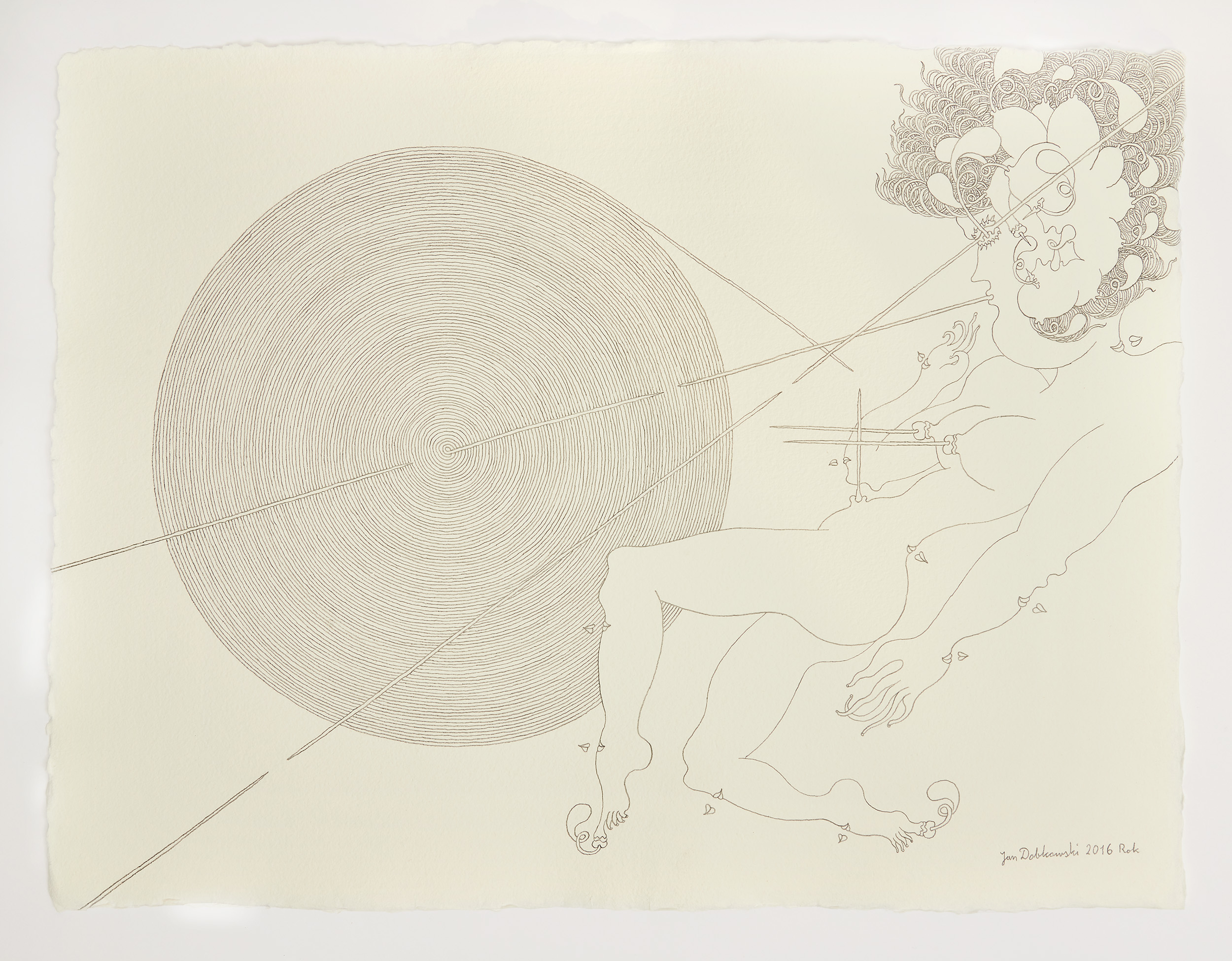
Jan Dobkowski, from the series ‘Take a Swing on the Thread of Life’, 2001–2011, pencil, handmade paper, 35×44 cm, private collection
At some moments, structures normally found on one part of the body are substituted and exchanged elsewhere. In many images, a big toe, a tongue, or a nipple incorporate a mushroom-like tip akin to the glans of a penis or a clitoris, and ears become contorted double dicks that spew out information. These forms are never just left as they are, but instead serve as apertures from which fluid forms flow forth. One ubiquitous substance that emerges from these points could possibly be identified as semen or milk, but at other times they are more recognizable as organs or gonads of ambiguous determination, at once ovaries and testicles, as if imagining a time before sex is established. Often spilling and coiling from the figure’s eyes, bellybutton, anus, breasts, genitals, and phallic toes, these liquid, teardrop-like forms are reminiscent of the Persian “boteh” motif found in decorative patterns such as paisley, which was popular in the psychedelic movement. Yet the organs play too much of an active role in the makeup of these bodies to be reduced to simple compositional or stylistic add-ons. Instead, these plasmatic discharges suggest a reproductive capacity outside biological determination, and imply the possibility for new bodies to emerge from these forms like mycelial spores.
In addition to their floating choreography, the primary medium for the figures’ interaction is the line that radiates out from their orifices like reproductive fluid. Unlike the organ-like effluvia, the thin line’s largely undeviating behavior renders something much more solid, which the characters can grab onto or stand on. The line shoots straight from their navels and nipples, penises and pudenda, and glows from the characters’ eyes like a laser beam or line of sight, directing attention toward invisible compositional points in the picture, and spinning into dense labyrinthine spirals. Here, fornication is described as the delivery and exchange of forces – at once sacred and profane – which follow their own logics of desire and sensation. The characters constantly change not only their bodily conditions, but also the sites and forms of their interchange. Freed from biological constraints and gendered expectations, Dobkowski’s figures deploy sensuality as a site for experimentation and mutual change, akin to Rosi Braidotti’s description of sexuality as “an active space of empowerment and becoming that is capable of producing spaces of intimacy, experimentation, and relation to others.”[25] Dobkowski remaps bodily relations by using sexuality as an organizing mechanism that establishes new encounters and resonances.
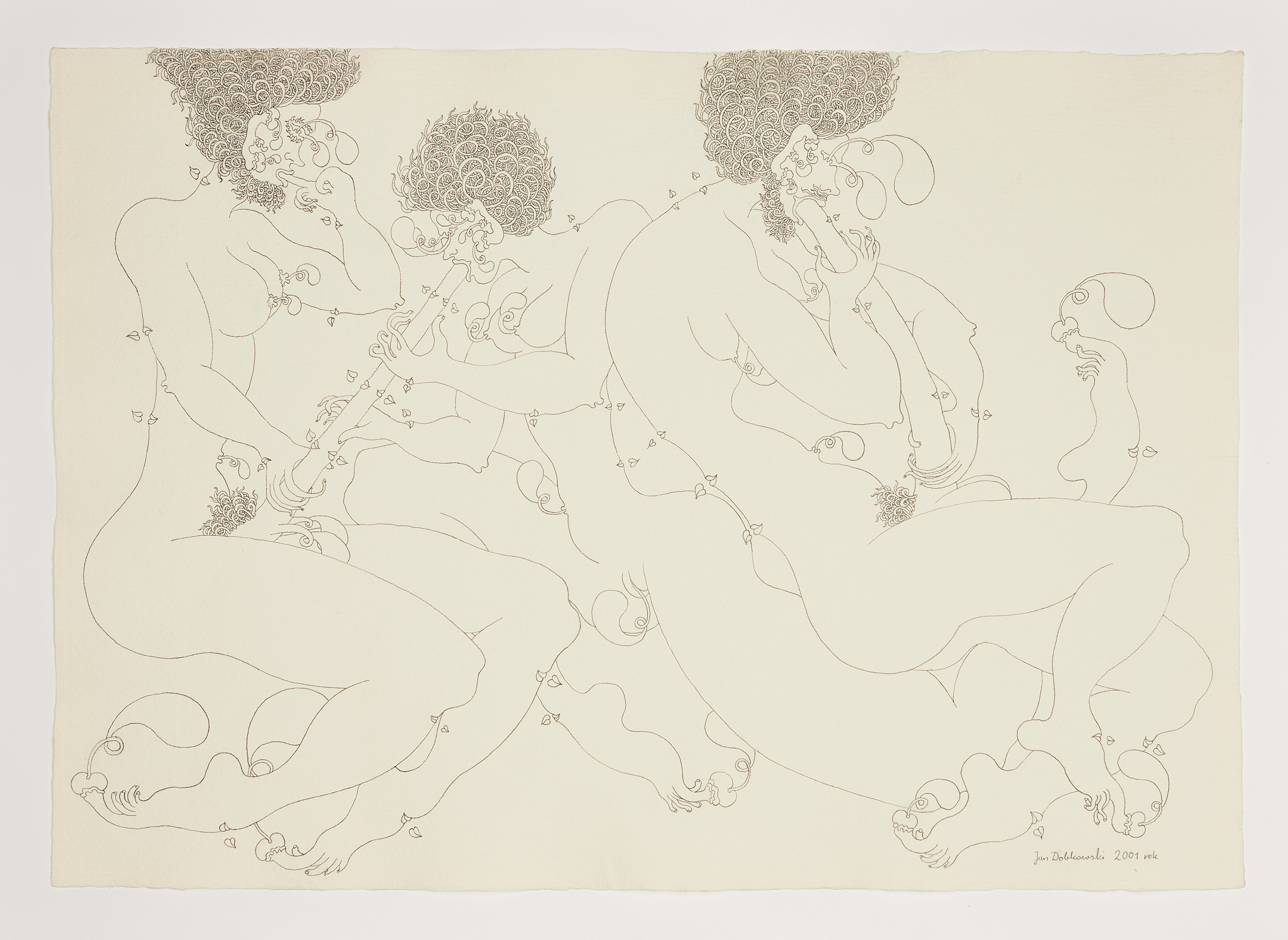
Jan Dobkowski, from the series ‘Take a Swing on the Thread of Life’, 2001–2011, pencil, handmade paper, 35×44 cm, private collection
Dobkowski often deploys experiments in symmetry to map relations between his figures and to exaggerate the sagittal planes that bisect the body. This formal maneuver gives the illusion of interchangeability, yet it also makes miniscule disparities between the figures more visible, stimulating an exercise in comparison and contrast, sameness and difference. Here, transformation is staged not only as something enacted within the figure itself, but as part of a mathematical logic of translation, reflection, and rotation within the picture’s plane. A formal language is developed, where the body is liberated from the expectation to represent and embraces its abstraction. As a piece of design, the forms gain affective powers independent of their figurative identities. They organize their environment by mapping out compositional meridian lines and balancing out formal weight, constructing a picture as an indivisible whole. Akin to synchronized swimming, the bodies work together to produce geometric compositions, reducing the individual to a component of a collective image. This dynamic is perhaps most apparent in a series of etching-like oil paintings of carnelian line figures on black which Dobkowski made in 1980. In Balance [Równowaga] (1980), a pair of elongated multigendered characters surround the canvas at its edge like sentries guarding an entrance. Entwining their phallic toes and emitting bubbles from their eyes, they extend their erections to form a perfect triangle. At the apex, and between the toes, the organs discharge tongue-like synapses for connection. Mirroring each other and relegated to the margins, they find a means of crossing the empty black expanse. Closed System [Układ zamknięty] (1980) also involves bodies binding space by banding together. Here, the pair “close the circuit” by accommodating their differences, where one stretches its body around the corner to enjoy a kiss, and the other extends its penis shaft to diagonally bisect the image and meet its partner on the other side. By occupying the border of the image, this series recalls the marginalia of illuminated manuscripts – the spaces at the edges of canonical knowledge where coded narratives were told through repetition, pattern, and illustration. The couple’s ornate curvilinear contours and the scrupulous squiggles surrounding the image add to the legacy of decorative art incorporating natural forms and illustrative motifs, which can be seen not only in Baroque, Rococo, Art Deco, psychedelia, and the Arts and Crafts movement, but also in folk traditions around the world. Inscribed on the surface as if painted on an ancient cave with a vulgarity of detail, these images propose ornament as a site for staging narrative and bodily interaction.
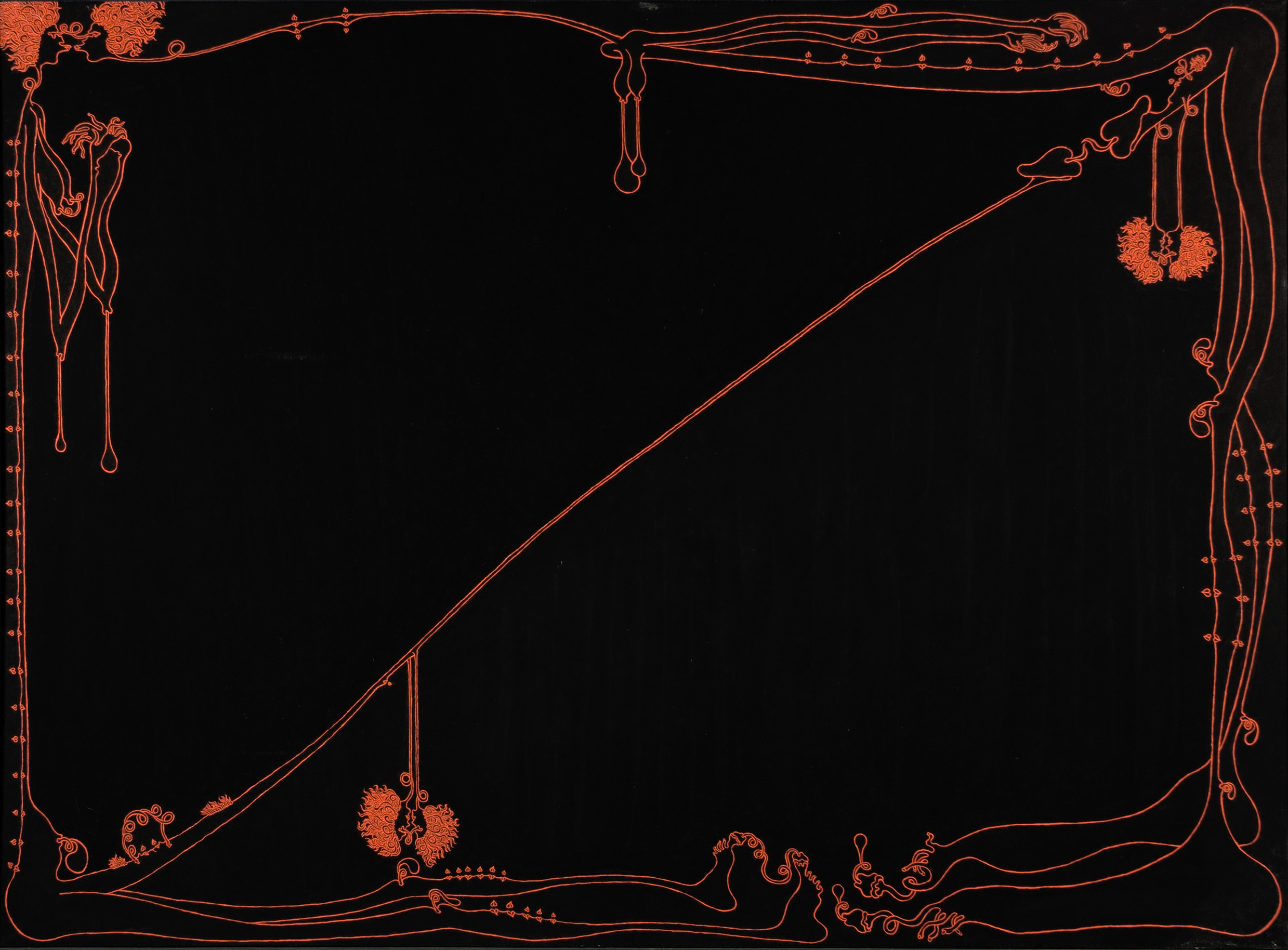
Jan Dobkowski, ‘Closed System’, 1980, oil, canvas, 147×197 cm, courtesy of the Polish Modern Art Foundation
There is something inherently theatrical about Dobkowski’s work, not only due to the parade of figures who make their appearances on his stage, but that each image constructs its own microcosm of the world, opening the curtain to reveal the possibilities behind it. In Eroticon [Erotikon] (1980, from the same series), the opposing figures’ phalluses expand and engorge to occupy most of the composition. From these penis-heavy bodies, smaller bodies sprout and interact, producing a mycelial mesh of micro-organisms propagating themselves and composing and decomposing the whole. With fuzzy gonads and impish and intimate behaviors, the multiplication of minute bodies in the image is reminiscent of mythological illustrations of fairies – normally unseen – proliferating through the natural world. Here, Dobkowski inspires ecological awareness by making visible things happening on multiple scales simultaneously. This recursive staging of micro- and macro-interrelations is inherently fractal: it describes a logic of self-similarity, iteration, and dynamic interaction across magnitudes that can be found not only in the abstract space of mathematics, but also in cellular biology and ecology. Occupying fractional dimensional spaces within and across the contours of the body, the image breaks from conventions of space and embodiment, and makes visible the singular organism as a recombinant assemblage of multiplicities.
In addition to his dense line paintings, Dobkowski’s fractalization of bodies is perhaps most apparent in his recent series Algorithm of Color and Space [Algorytm koloru i przestrzeni] (2019–2020), which, counter-intuitively, features no reference to the figure at all, reducing form to primary operators. Framed by an aquatic blue border, these multicolored geometric square abstractions are composed of tessellated triangles that fragment toward their centers into smaller triangles. Monstrous calculating devices that transform the concept of measure and multiplicity, the fractal compositions stage intimate relations between fragmented zones, which are in constant mutual influence. The repetition of forms is comparable to the mystical Hindu diagram of the Shri Yantra, where the overlapping and interlocking of triangles represents the fractal interrelation of the body to the larger cosmos. While this series departs from Dobkowski’s vulgar and plasmatic figuration, it nevertheless elucidates a similar logic, where forms fluctuate, flow, and generate a collective from disparate parts. Like the organs, genitals, and other body parts, the triangular zones of color operate as repeated and partitioned morphologies that continuously reorganize their interrelation, shifting formal weight through subtle transformation and inversion. Using the variation of hues to catalyze both complementary and discordant color relations, the identity of each colored shape changes as it is distributed across the picture’s plane, generating vibrant affects that erupt from phenomenological apprehension rather than any innate qualities. Once again, identity is shown to be contingent and constantly varying according to an oscillation of relations. The borders between shapes are only imaginary lines that appear from the intimate rubbing together of forms, which become symbiotic assemblages that are co-extensive across scales. Without hierarchy, yet still operating through difference and variation, the entangled relations generate a collective vitality that connects the mundane to the cosmic. As inhuman and unnatural as mathematically precise forms can seem, Dobkowski finds a way to make colors and shapes become markers of embodiment, which inhabit an ecology. Sergei Eisenstein noted a similar operation: “The heartless geometrizing and metaphysics here give rise to a kind of antithesis, an unexpected rebirth of universal animism.”[26]
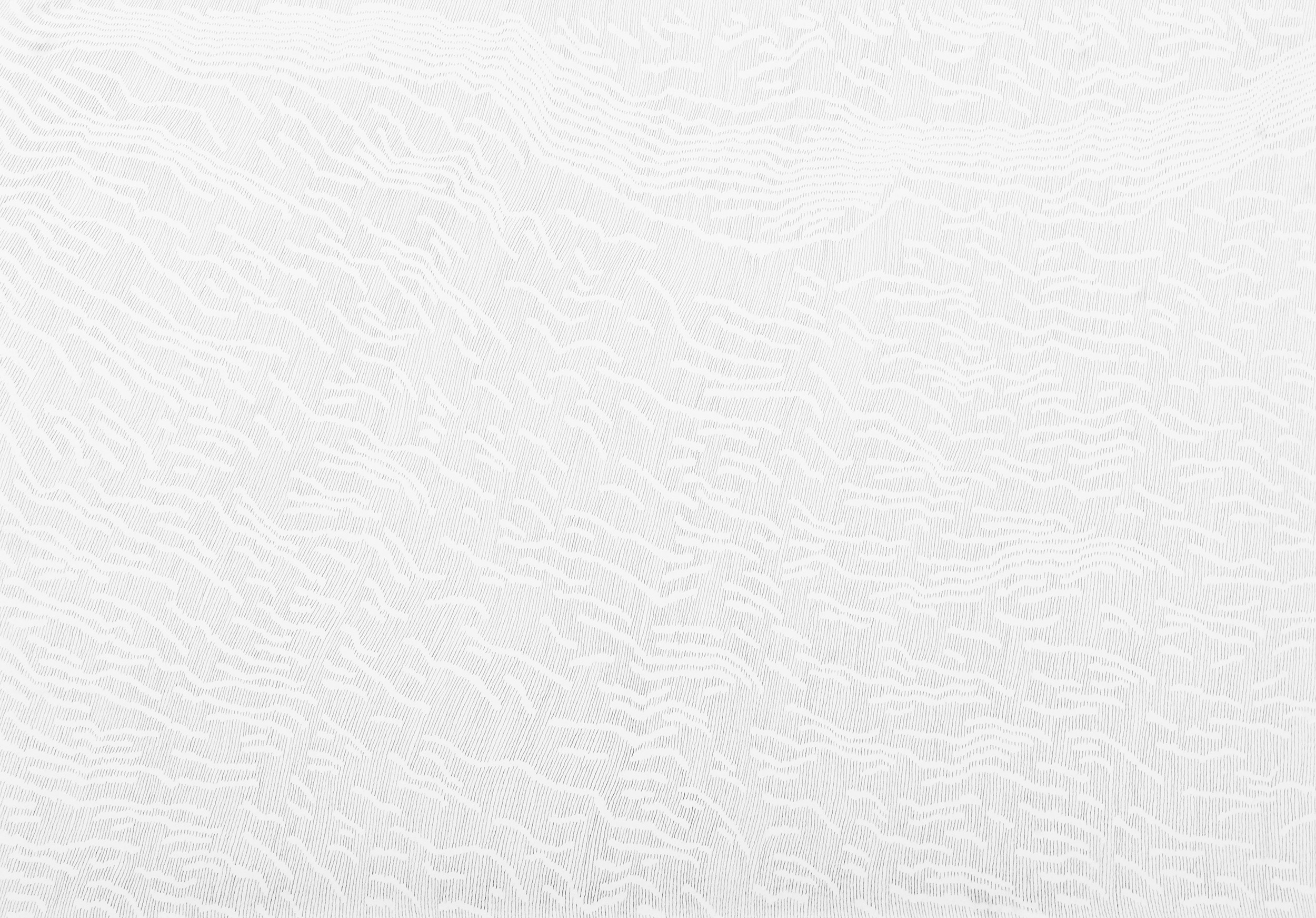
Jan Dobkowski, from the series ‘Genesis XLVI’, 1986, pencil, paper, 72.5×50.5 cm, private collection
Throughout Dobkowski’s practice, a multiplicity of forms gathers to generate a larger collective reality, building a cosmology that is at once sacred and profane. His works attempt to access an archaic formlessness, drawing from a proto-subjective, prehistoric, and pre-capitalist space, what Félix Guattari calls “a dimension of creativity in a nascent state.”[27] For Dobkowski, this space before forms and relations became fixed and controlled offers a counter-measure to the rigid structures that have detached us from ourselves, each other, and our world, on many enmeshed levels and across all magnitudes. Dobkowski’s creatures exist in a primordial protoplasm; they are amoebic beings in fluid interaction, forming and deforming their bodies in dialogue with others. By mobilizing a plasmatic and indeterminate substance, he makes visible the fact that all structures can be undermined, and that all forms have a latent logic which requires and thrives through volatility. Dobkowski’s bestiaries of polymorphic and mutagenic embodiment contest the body as a stable and singular entity, and demonstrate the intimacy of our entanglements with each other. His mutagenic language evokes constant evolution and symbiosis, as well as the expectation of continuous change. Using a multivalent approach to the body, and deploying the line as an abstract yet primordial tool for the genesis of relations, Dobkowski builds “worlds of infancy, madness, amorous passion, and artistic creation.”[28]
The text was first published in the book Jan Dobkowski. Monografia, edited by Dr. Marika Kuźmicz in collaboration with Marianna Dobkowska, published by the Arton Foundation (2020).
[1] Rosi Braidotti, Transpositions: On Nomadic Ethics (Cambridge: Polity Press, 2006), 31.
[2] Maurice Merleau-Ponty, “Eye and Mind,” in: idem, The Primacy of Perception, ed. James M. Edie, trans. Carleton Dallery (Evanston: Northwestern University Press, 1964), 184.
[3] Alfred North Whitehead, “Theories of the Bifurcation of Nature,” in: idem, The Concept of Nature (Cambridge: Cambridge University Press, 1920), 26–48.
[4] Janusz Zagrodzki, “On the Thread of Life,” in: Take a Swing on the Thread of Life, ed. Marianna Dobkowski (Baden: Kodoji Press, 2014), n.p.
[5] Jan Dobkowski, interview in Common Review, June 1986.
[6] Sergei Eisenstein, Eisenstein on Disney, ed. Jay Leyda, trans. Alan Upchurch (Calcutta: Seagull Books. 1986), 33.
[7] Ibid.
[8] This is a paraphrase of Bruno Latour on plasma: “What kind of potentials can be found in a phenomena that has not yet been formatted, not yet measured, not yet socialized, not yet engaged in metrological chains, and not yet covered, surveyed, mobilized, or subjectified?” Bruno Latour, Reassembling the Social: An Introduction to Actor-Network Theory (Oxford: Oxford University Press, 2005), 244.
[9] Eisenstein, Eisenstein on Disney, 21.
[10] Ibid., 35.
[11] “All that is solid melts into air.” Karl Marx and Friedrich Engels, The Communist Manifesto (London–Chicago: Pluto Press, 1996).
[12] Zygmunt Bauman, “Foreword to the 2012 Edition: Liquid Modernity Revisited,” in: idem, Liquid Modernity (Cambridge: Polity Press, 2000, reprinted in 2012), viii.
[13] Ibid.
[14] Merleau-Ponty, “Eye and Mind,” 183.
[15] Keith Broadfoot and Rex Butler, “The Illusion of Illusion” (1991), in: The Illusion of Life: Essays on Animation, ed. Alan Cholodenko (Sydney: Power Publications, 1991), 263–298: 288.
[16] Zagrodzki, “On the Thread of Life,” n.p.
[17] Merleau-Ponty, “Eye and Mind,” 183.
[18] Ibid., 184.
[19] In his book A Realist Theory of Science, Roy Bhaskar criticized theories that flatten the world into its accessibility to human observers, dubbing such attempts as examples of a “flat ontology.” Manuel DeLanda borrowed Bhaskar’s phrase to propose “flat ontology” as an anti-reductionist term that treats all entities equally, describing a flat, non-hierarchical world, “made exclusively of unique, singular individuals, differing in spatio-temporal scale but not in ontological status.” As Graham Harman observes, the meaning of “flat” was here reversed: “rather than referring to a world without levels in which everything inhabits the realm of human consciousness, it means instead a world in which all levels are on the same playing field.” Within this pure definition of flattened interaction, any kind of hierarchy privileging the human over the non-human, life over non-life, the real over the representation, the natural over the artificial, the tangible over the intangible, the permanent over the transient, the large or complex over the small or simple, is eliminated. See: Roy Bhaskar, A Realist Theory of Science (1975) (London: Verso, 1997); Manuel DeLanda, Intensive Science and Virtual Philosophy (London & New York: Continuum, 2002), 58; Graham Harman, “The Road to Objects,” continent 3.1 (2011), 171–179: 177.
[20] Meta-Morphing: Visual Transformation and the Culture of Quick-Change, ed. Vivian Sobchack (Minneapolis: University of Minnesota Press, 2000).
[21] Dana Oswald, “Monstrous Gender: Geographies of Ambiguity,” in: The Ashgate Research Companion to Monsters and the Monstrous, eds. Asa Simon Mittman and Peter J. Dendle (London: Ashgate, 2012), 362.
[22] Gérard Seiterle, “Artemis: die Grosse Göttin von Ephesos,” Antike Welt 10 (1979), 3–16.
[23] Zagrodzki, “On the Thread of Life,” n.p.
[24] Sigmund Freud (1953), The Standard Edition of the Complete Psychological Works of Sigmund Freud, Volume VII, trans. James Strachey (London: Hogarth, 1974), 191.
[25] Rosi Braidotti, “Nomadic Ethics,” Deleuze Studies 7.3 (2013), 353.
[26] Eisenstein, Eisenstein on Disney, 35.
[27] Félix Guattari, Chaosmosis: An Ethico-aesthetic Paradigm, trans. Paul Bains and Julian Pefanis (Bloomington: Indiana University Press, 1995), 101.
[28] Ibid.
Imprint
| Author | Marika Kuźmicz (ed.) in collaboration with Marianna Dobkowska |
| Title | Jan Dobkowski. Monografia |
| Publisher | Arton Foundation |
| Published | 2020, Warsaw |
| Index | Arton Foundation Jan Dobkowski Marianna Dobkowska Marika Kuźmicz Post Brothers |


